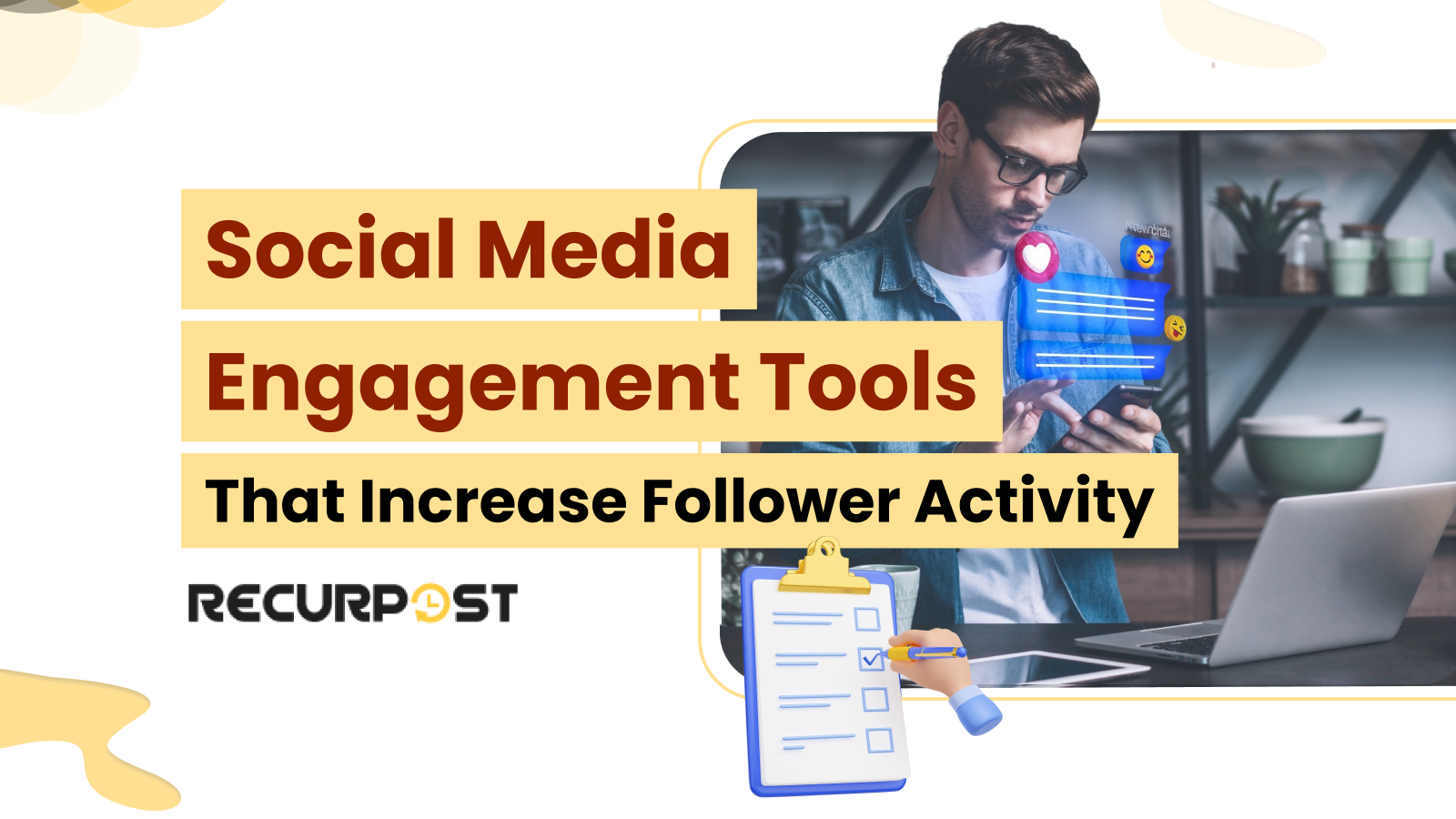Across social media platforms, engagement drives success. Without effective social media engagement tools, building genuine audience connections becomes challenging. Social media engagement tools designed for follower interaction simplify audience retention and trust building.
These tools analyze audiences, track metrics, and increase brand accessibility. In fact, tracking metrics such as likes, comments, and shares is essential for brand success, as highlighted in Forbes’ list of 20 essential social media metrics. These tools help companies receive thousands of likes, comments, and direct messages a social media channels daily.
High engagement indicates market impact and brand affinity. Social media engagement tools can turn simple interactions into lasting relationships.
Social Media Engagement

Social Media Engagement quantifies interaction between brands and audiences across social media platforms. Social media engagement tools help track these engagement metrics, including interactions such as:
- Likes
- Comments
- Shares
- Hashtags
- Retweeting, reposting, or mentioning
- Saving a post for later
- Clicking on a post’s link
- Viewing a video
- Direct messages
High engagement, measured by social media engagement tools, shows audiences find content valuable, relatable, or entertaining, which builds community, trust, and loyalty around brands. Social media engagement strategies, tracked with social media engagement tools, enhance content performance.
Why Social Media Engagement Matters
Social media engagement involves interaction beyond posting content, encompassing liking, commenting, sharing, and messaging. Direct audience engagement, supported by social media engagement tools, forms personal connections that make followers feel valued, strengthening loyalty.
Strong engagement, measured by social media engagement tools, differentiates brands, creates genuine connections, and increases visibility in crowded online spaces.
Social Media Engagement Tools
Social media engagement tools allow companies and marketing teams to track engagement metrics.
Marketers use social media engagement tools to monitor conversations, respond to customer requests, publish and schedule content, and automate repetitive tasks, creating time for content creation, networking, and community building.
Successful social media teams use multiple social media engagement tools to remain relevant and topical and maintain audience interest in their content.
Importance of Social Media Engagement Tools
Social media engagement tools strengthen audience connections by revealing how followers react, interact, and respond to shared content. Social media engagement tools monitor likes, comments, and shares, showing what audiences enjoy and value.
These social media engagement tools reduce workload through advanced post-scheduling and centralized message management, supporting relationship building and sustaining follower engagement with brands.
Features of Social Media Engagement Tools
When selecting social media engagement tools, consider these key features to meet your needs.
1. Real-time Monitoring and Engagement
Social media engagement tools that monitor social media conversations in real time enable quick responses to comments and messages, thereby maintaining audience connection. Real-time social engagement monitoring tracks mentions, hashtags, and brand conversations across platforms instantly, alerting teams to respond within minutes rather than hours.
Advanced monitoring capabilities include sentiment detection, keyword tracking, and automated notifications for urgent situations, such as customer complaints or viral mentions. Real-time engagement makes followers feel heard and appreciated, building brand loyalty. While preventing potential reputation issues from escalating.
2. Analytics and Reporting
Effective social media engagement tools provide comprehensive analytics and reporting features that track metrics like engagement rates, reach, and follower growth. Performance data guides content strategy decisions and identifies what resonates with audiences.
3. Collaboration Features
Collaboration features serve team environments. Select social media engagement tools that allow multiple users to manage accounts, share insights, and coordinate campaigns. This promotes teamwork and aligns social media strategies across teams.
4. Automation Options
Automation maintains a consistent presence while reducing workload. Scheduling tools enable advanced post planning, ensuring content is published at the best time, allocating resources for audience engagement beyond posting.
5. Identify Trends in Social Media
Social media trend identification and analysis provide a competitive advantage. Social media engagement tools that show popular topics help tailor content for relevance. Understanding trends helps you join timely discussions and reach larger audiences.
6. User-Friendly Interface
A user-friendly interface improves your social media workflow. Choose social media engagement tools that are easy to navigate without extensive training. A clean design with intuitive features lets you focus on audience engagement instead of learning the tool.
7. Sentiment Analysis
Sentiment analysis shows how your audience feels about your brand. By analyzing the tone of comments and messages, you can gauge overall sentiment and adjust your strategy. This shows not just what people are saying, but their emotional response to your content.
8. Platform Supports
Select social media engagement tools supporting all your social media platforms. Whether brands operate on Facebook, Instagram, Twitter, or LinkedIn, appropriate social media management tools manage all accounts in one location. This consolidates social media management and enhances efficiency.
9. Budget and Pricing Models
Choose from various pricing options, from free plans to premium packages, that fit your budget without compromising essential features.
10. Integration Needs
Choose social media engagement tools that integrate with existing software, such as CRM systems or analytics platforms, to establish seamless marketing workflows.
Social Media Engagement Platforms VS Social Media Engagement Tools
Social media engagement platforms deliver comprehensive solutions beyond individual engagement tools. While specific social media engagement tools handle functions like scheduling or analytics, platforms offer all-in-one environments where multiple engagement functions work together seamlessly.
Social media engagement platforms combine integrated tools functioning under one dashboard. Teams monitor conversations, schedule content, analyze performance, and engage audiences across multiple networks without changing applications.
RecurPost operates as a complete social media engagement platform providing comprehensive solutions for content scheduling, recycling, analytics, and audience engagement in one unified system.
Top 5 Social Media Engagement Tools
1. RecurPost
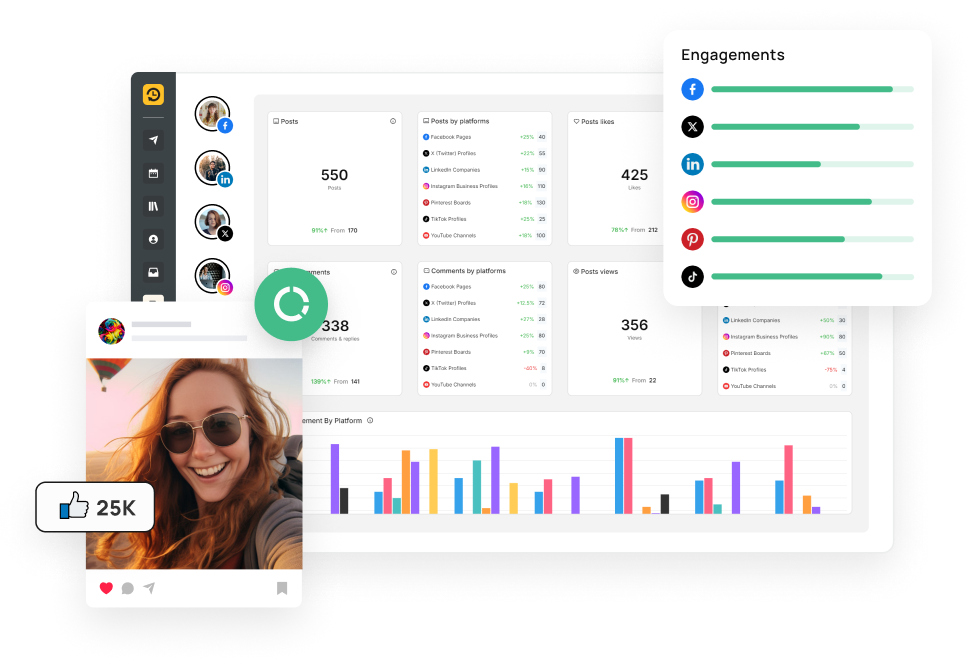
RecurPost stands out with its content-recycling approach. This tool schedules posts on repeating cycles, allowing the best content to reach new audiences over time. RecurPost manages multiple social media accounts simultaneously.
Pricing: Starts at $9 per month for individual users. Business plans are available at higher tiers.
Best for: Brands and marketers who want to automate their social media presence and ensure consistent engagement without constantly creating new content.
Key Features
- Real-time Monitoring and Engagement: As one of the top social media engagement tools, it allows you to monitor comments and messages across various social platforms, enabling quick responses to engage with your audience effectively.
- Analytics and Reporting: This tool provides detailed analytics on post-performance, audience engagement, and growth metrics, helping you track what content resonates best.
- Collaboration Features: With options for team collaboration, It makes it easy for multiple users to manage accounts, share insights, and work on campaigns together.
- Automation Options: You can schedule posts in advance and create content libraries to automate your social media presence, ensuring consistent posting.
- User-Friendly Interface: The intuitive design makes it easy for users of all skill levels to navigate the platform without extensive training.
- Platform Supports: It supports multiple social media platforms, including Facebook, Twitter, LinkedIn, and Instagram, allowing for streamlined management.
- Integration Needs: Integrates smoothly with Canva for design and Zapier for additional automation.
- Budget and Pricing Models: RecurPost offers a free plan that includes basic scheduling and recycling features for up to 3 social media accounts. This free tier makes it accessible for small businesses and individuals just starting with social media management, while paid plans unlock additional features and account capacity.
Compare features in our detailed RecurPost vs Ocoya guide to see which tool fits your needs best.
2. Hootsuite
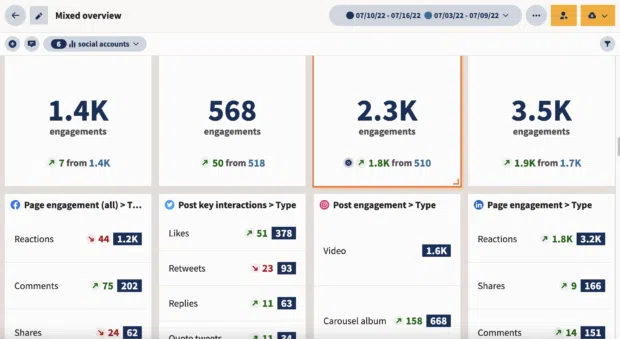
Hootsuite is a popular social media management tool that allows users to schedule posts, track engagement, and manage multiple social media accounts from a single dashboard. Its comprehensive analytics provide insights into performance, helping you refine your strategy.
Pricing: Plans start at $19 per month for individuals, with additional costs for teams and features.
Best for: Businesses looking for a comprehensive tool to manage multiple social media accounts and analyze performance.
Key Features
- Real-time Monitoring and Engagement: This social media engagement tool allows you to monitor multiple social media channels in one dashboard, enabling quick responses to comments and messages.
- Analytics and Reporting: Provide detailed analytics and customizable reports to track your social media performance over time.
- Collaboration Features: Supports team collaboration with shared access and task assignments, making it easier for teams to work together.
- Automation Options: Offers scheduling capabilities for posts across various platforms, allowing you to plan your content in advance.
- User-Friendly Interface: The intuitive layout makes it easy for users of all levels to navigate and use effectively.
- Platform Supports: Compatible with numerous platforms, including Facebook, Instagram, Twitter, LinkedIn, and more.
- Integration Needs: Works with Slack, Canva, and Google Analytics, making it ideal for teams using multiple apps.
Explore a Detailed Comparison of Hootsuite vs Agorapulse
3. Sprout Social
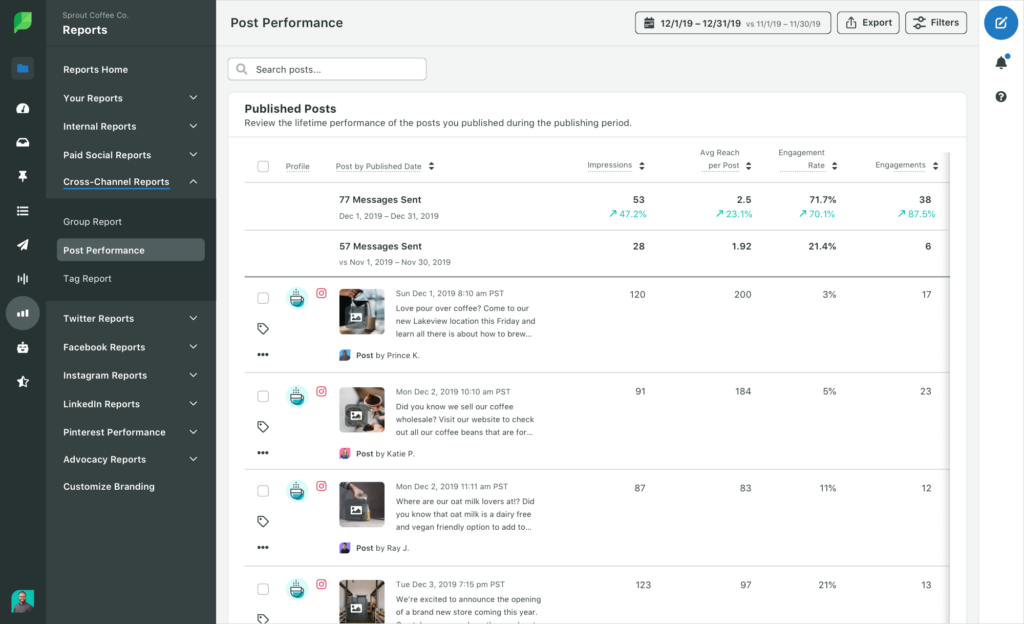
Sprout Social offers powerful social media engagement tools with advanced analytics and reporting features. It helps brands understand their audience and improve their content strategies through in-depth insights.
Pricing: Plans start at $89/month, including features for 5 social profiles and advanced reporting.
Best for: Medium to large businesses wanting robust analytics and team collaboration capabilities.
Key Features
- Real-time Monitoring and Engagement: Features a smart inbox to manage all incoming messages and mentions in real-time.
- Analytics and Reporting: Provides comprehensive analytics, including engagement metrics, demographic insights, and performance comparisons.
- Collaboration Features: Includes team planning and collaboration tools, allowing for seamless content creation and approval workflows.
- Automation Options: Allows you to schedule posts and set up automated responses for common queries.
- User-Friendly Interface: Designed with a clean, straightforward interface that makes it easy to navigate and find essential features.
- Platform Supports: Supports major social media platforms such as Facebook, Twitter, Instagram, LinkedIn, and Pinterest.
- Integration Needs: Integrates with CRM tools like HubSpot and Salesforce, enhancing customer engagement strategies.
Agorapulse vs Sprout Social – Which is Best in 2025?
4. Buffer
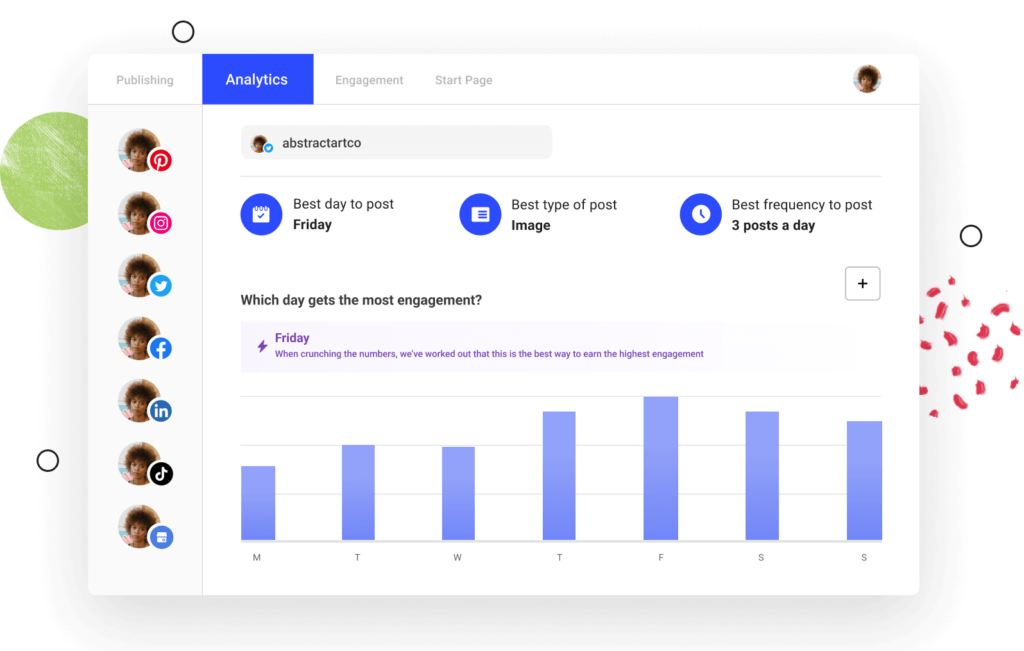
Buffer is known for its simplicity and effectiveness in scheduling posts across various social media platforms. Its user-friendly interface makes it easy to manage content and analyze engagement without any hassle.
Pricing: Plans start at $15/month for the Essentials plan, which covers up to 10 social profiles.
Best for: Small businesses and individuals who want a straightforward, no-frills scheduling tool.
Key Features
- Real-time Monitoring and Engagement: This social media engagement tool lets you monitor comments and interactions in real-time, helping you stay engaged with your audience.
- Analytics and Reporting: Offers basic analytics to assess how your posts are performing, including engagement rates and reach.
- Collaboration Features: Supports team collaboration with user roles and permissions, making it easy for teams to manage content.
- Automation Options: You can schedule posts for optimal times and use the queue feature for ongoing content delivery.
- User-Friendly Interface: The simple design makes it easy for anyone to learn how to use the tool quickly.
- Platform Supports: Integrates with multiple platforms, including Facebook, Twitter, Instagram, LinkedIn, and Pinterest.
- Integration Needs: Connects with Zapier, Canva, and Google Drive for content storage and management.
Buffer Vs Agorapulse | Buffer Vs Coschedule | Buffer vs Metricool | Buffer Vs. SproutSocial
5. Later
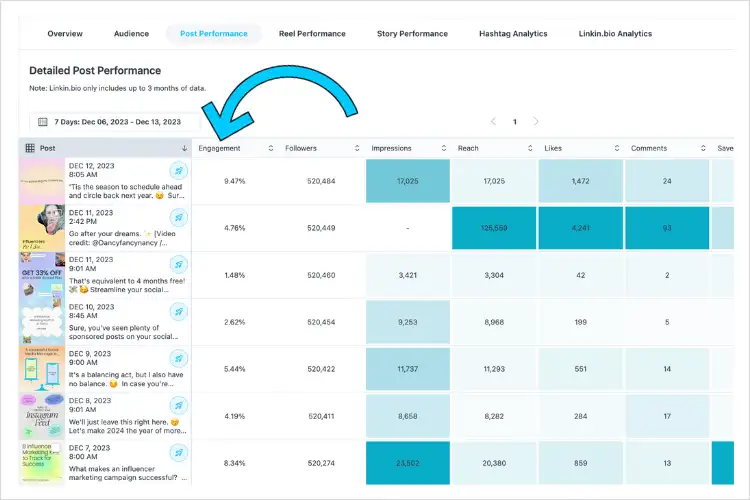
Later visually plans and schedules posts, particularly for Instagram. Its drag-and-drop interface creates aesthetically pleasing feeds while monitoring engagement, making it a valuable social media engagement tool.
Pricing: Plans start at $12.50/month for the Starter plan, which includes 4 social profiles and basic analytics.
Best for: Brands focusing on visual content and Instagram marketing.
Key Features
- Real-time Monitoring and Engagement: While it is primarily a visual planner, it allows you to monitor comments and messages for timely engagement.
- Analytics and Reporting: Offers insights on post performance and audience engagement, helping you refine your strategy.
- Collaboration Features: Allows team members to collaborate on content creation and approval processes.
- Automation Options: Focuses on visual content scheduling, making it easy to plan Instagram posts, stories, and more in advance.
- User-Friendly Interface: Known for its drag-and-drop functionality, it is very intuitive and easy to use.
- Platform Supports: Primarily focused on Instagram but also supports Facebook, Twitter, and Pinterest.
- Integration Needs: Integrates with Shopify, Canva, and other tools focused on visual content creation.
Social Media Engagement Tips for Agencies
Social media engagement drives meaningful connections and client success. Here are practical tips for agencies to boost engagement and showcase measurable results.
Content Strategies to Drive Engagement
1. Host Giveaways and Contests

Agencies create giveaways boosting engagement through likes, shares, and comments. Contests increase reach and attract new followers. Relevant prizes attract genuine engagement from client audiences, especially when managed through social media engagement tools.
2. Use FOMO (Fear of Missing Out) Posts

FOMO posts create urgency through “limited-time offers”, “exclusive access”, or “last-chance deals”. This approach encourages immediate action and interaction, especially when shared across multiple platforms using social media engagement tools.
3. Share User-Generated Content (UGC)

Agencies can amplify engagement by sharing content from real users and customers. UGC not only makes followers feel appreciated but also serves as a form of social proof. This tactic builds trust with the audience and encourages others to share their experiences, fostering a sense of community around the brand with the help of social media engagement tools.
4. Engage with Interactive Content
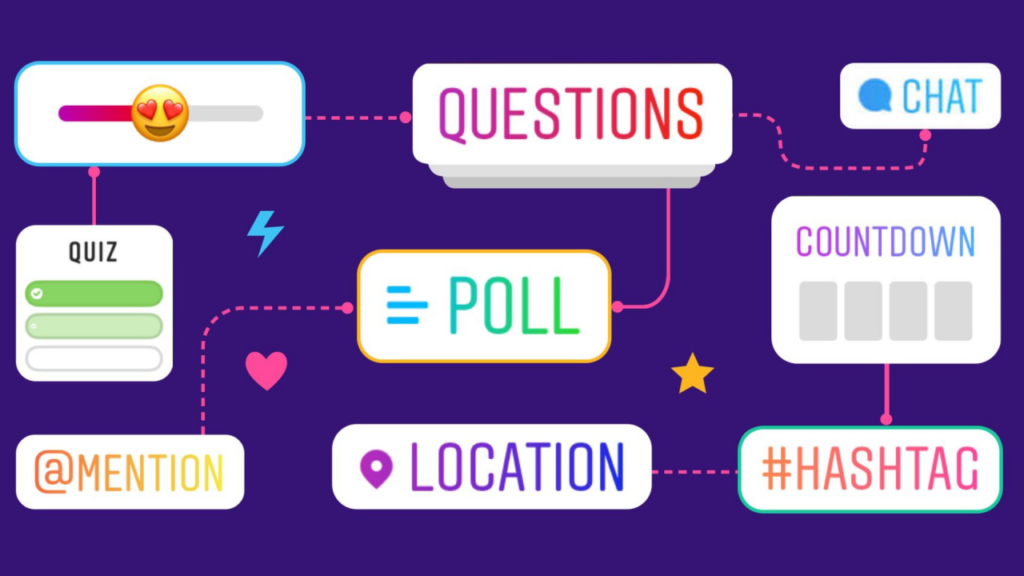
Polls, quizzes, and Q&A sessions allow followers to participate actively, making them feel connected to the brand. Agencies can use interactive content in Instagram Stories, Facebook posts, or Twitter polls to boost engagement and gather insights about audience preferences. Social media engagement tools make it easier to organize and analyze these interactions.
5. Create Fan-Specific Engagement Opportunities
For brands with dedicated fan bases, creating specialized engagement opportunities can significantly boost interaction. Fan engagement tools within platforms like RecurPost allow brands to create exclusive content for loyal followers, run fan-only contests, and develop ambassador programs. These specialized approaches make fans feel valued and recognized, turning casual followers into brand advocates who actively promote your content.
Using Analytics to Refine Engagement
1. Track Engagement Metrics to Measure What Works
Start by tracking core engagement metrics like likes, shares, comments, and click-through rates using social media engagement tools. Identify the types of content that receive the highest engagement, and use these insights to shape future strategies. By focusing on high-performing posts, agencies can refine their content approach to consistently deliver what resonates with the audience.
2. Use Demographics to Target the Right Audience

Analytics tools within social media engagement tools often provide demographic data, including age, location, and interests. Understanding who is most engaged with the content allows agencies to better target their audience. Tailor content specifically for these groups, as engagement increases when the content feels more personal and relevant.
3. Create and Share Client Reports
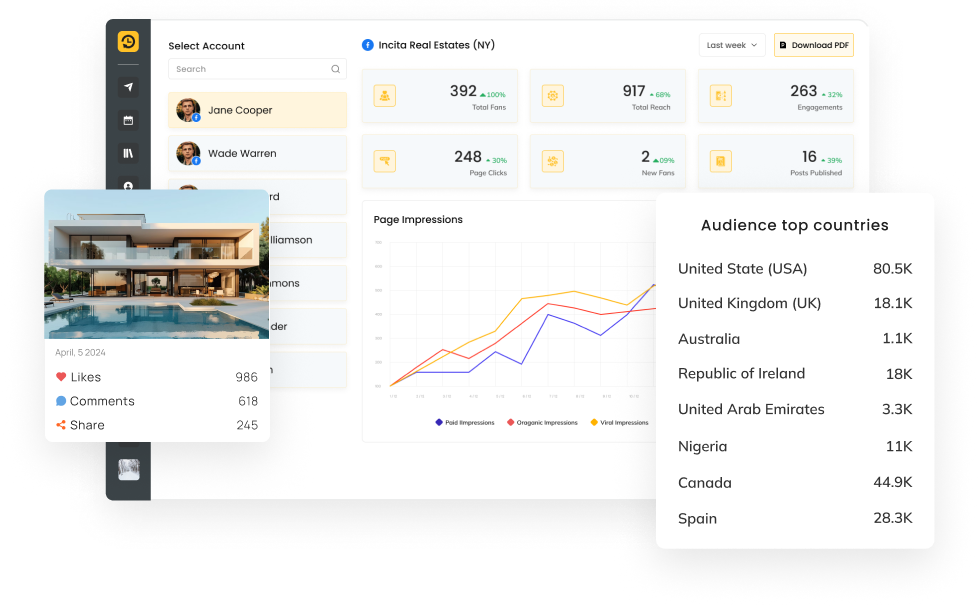
Regularly updating clients with clear, visual reports on engagement metrics from social media engagement tools can help justify the agency’s efforts. Use these reports to demonstrate what’s working, and provide recommendations for future campaigns. This transparency fosters client trust and shows them that engagement efforts are driven by measurable insights.
4. Experiment and A/B Test Content
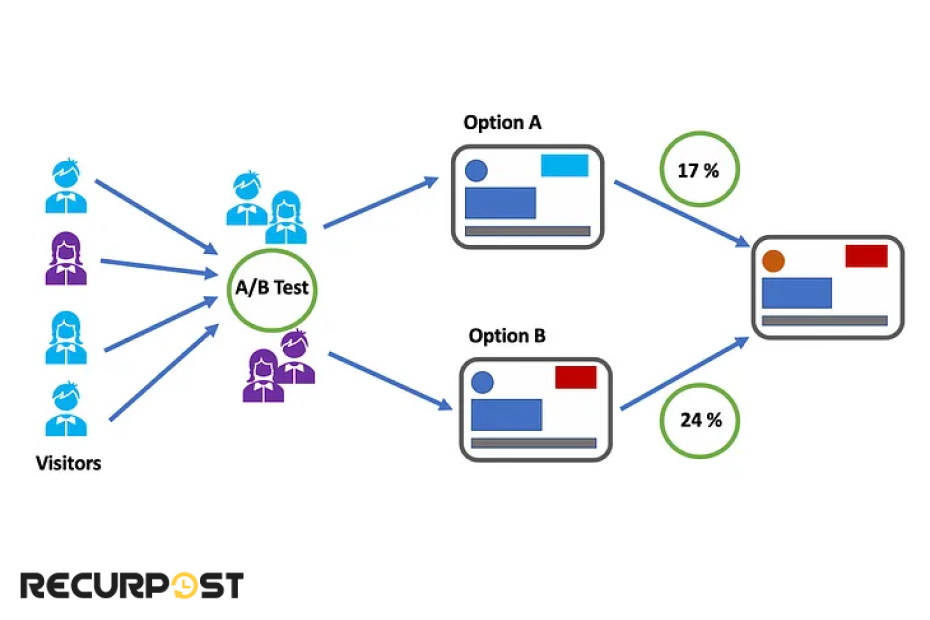
A/B testing different versions of content with social media engagement tools can help pinpoint what your audience responds to best. Try testing variations of images, captions, or post timing. Analytics will quickly show which versions yield higher engagement, allowing agencies to optimize future posts based on data-backed results.
5. Identify Trends in Engagement
Review past analytics in social media engagement tools to spot trends or seasonal spikes in engagement. If a particular type of post performed well last quarter, consider incorporating similar themes or formats in upcoming campaigns. By keeping track of engagement patterns, agencies can stay proactive in creating relevant, timely content that resonates.
Optimizing Social Media Engagement
1. Use Engagement Data to Refine Content Strategy
Social engagement optimization involves analyzing which content types, posting times, and messaging styles generate the highest engagement. RecurPost’s analytics tools help identify these patterns, allowing you to adjust your strategy accordingly. By continuously testing and refining your approach based on engagement metrics, you can systematically improve your content’s performance over time.
Check out our Best Time to Post on Social Media in 2025.
2. Implement Engagement-Focused Workflows
Creating workflows specifically designed to boost engagement can transform your social media results. This includes setting up automated responses to common questions, developing content series that encourage ongoing participation, and establishing regular check-ins to respond to comments and messages. RecurPost’s automation features help streamline these processes while maintaining authentic connections.
Benefits of Using Social Media Engagement Tools for Agencies
Social media engagement tools give agencies practical methods to connect with audiences, measure success, and maintain client satisfaction.
1. Enhanced Response Rates
These tools enable agencies to respond to comments and messages faster. Prompt responses make followers feel valued and build stronger connections. Followers who feel heard develop greater loyalty.
2. Data-Driven Insights
Engagement tools provide clear insights about effective content. By tracking likes, shares, and comments, agencies identify which posts generate the most interaction. This data refines future strategies to maintain high engagement.
3. Scalability
Client growth increases content and interaction management needs. Engagement tools simplify handling multiple accounts without overwhelming teams. Agencies can scale operations alongside client growth smoothly.
4. Competitive Positioning
Effective engagement tools help agencies demonstrate measurable success to clients. Data-backed high engagement rates demonstrate social media management value. This establishes agencies as reliable partners in client growth.
5. Generating Leads
Engagement tools convert followers into leads by identifying frequent brand interactions. Agencies target these engaged followers for customer conversion. Engaging content paired with lead generation expands client reach.
6. Customer Satisfaction and Building Relationships
Social media engagement tools facilitate follower communication, quick responses, and issue resolution. Satisfied customers frequently become repeat customers. Building genuine relationships helps agencies expand client fan bases.
7. Competitive Analysis
These tools monitor competitors’ social media activities. Observing successful competitor strategies allows agencies to adapt approaches for clients. This maintains client relevance and trend alignment.
Integrating Social Media Management Platform & Social Media Engagement Platform
Brand growth requires integrated social media management and engagement. Social media engagement tools and management tools plan, schedule, and track posts, while engagement platforms facilitate audience interaction. Combined, these tools simplify and enhance follower relationship building.
Social media management platforms like Hootsuite or Buffer help organize and schedule posts, making it easier to keep content consistent. These tools also track which posts get the most attention, providing insights into what the audience enjoys. Social media management software also allows teams to handle multiple accounts and organize their work, saving time and keeping everyone in sync.
Social media engagement platforms are all about connecting with people. These platforms help respond to comments, track messages, and monitor interactions across different channels. By using engagement platforms, brands can answer questions, respond to feedback, and show followers that they’re listening.
Integrating social media management tools with engagement tools makes campaign planning smoother. For example, an agency can plan and schedule a campaign using a management tool and track how people respond in real time with an engagement platform. This approach lets teams make quick adjustments to improve results, such as by replying to popular comments or answering common questions.
Conclusion
Social media engagement tools build stronger online brand connections. Mid-sized businesses managing multiple networks use these tools to organize content, interact with followers, and track engagement metrics in one place. Social media management platforms help teams create attention-grabbing content for targeted audiences.
Brands engage customers through participation in relevant conversations and feedback responses, showing attentiveness. This builds loyal, engaged communities that support brand growth and cross-platform presence.
Social media engagement tools simplify management, helping brands connect with their audience, build loyalty, handle social media, and drive meaningful interactions.
FAQs on Social Media Engagement Tools
1. How do analytics improve engagement strategies?
Detailed analytics help improve engagement strategies by showing what content resonates most with the audience. Tracking metrics like likes, shares, and comments shows which posts perform well, allowing brands to adjust their content accordingly. Analytics show audience demographics, helping brands tailor posts to specific groups for more relevant and effective engagement.
2. Can small agencies benefit from these tools?
Small agencies benefit from these tools. These tools save time by organizing posts, tracking engagement, and managing multiple networks in one place. Small teams can create attention-grabbing content and engage customers effectively, making a significant impact without a large staff.
3. Which tools work best for specific social platforms?
Facebook pages
RecurPost: Great for scheduling posts, monitoring comments, and analyzing performance.
Buffer: Simple to use for planning and publishing content.
Instagram
Later: Perfect for visually planning and scheduling posts. It also supports stories.
Canva: Excellent for creating eye-catching graphics and stories.
4. What is the difference between a social media engagement tool and a social media management tool?
A Social media engagement tool focuses on interacting with your audience. It helps you respond to comments, messages, and mentions, making it easier to connect with followers and build relationships.
On the other hand, a social media management tool is about organizing and scheduling your social media posts. It helps you plan content, track performance, and manage multiple accounts from one place.
5. What is the difference between a social media listening tool and a social media engagement tool?
Social Listening Tools focus on monitoring online conversations and gathering insights about what people are saying about a brand, industry, or competitors. They track mentions, keywords, and trends, helping brands understand public sentiment and identify opportunities for improvement or engagement.
On the other hand, Engagement Tools are designed to facilitate direct interaction with followers. They allow brands to respond to comments, manage messages, and engage with users across different platforms. The goal here is to foster relationships, build community, and drive engagement through conversations.
6. How do engagement tools help in community management?
Engagement tools play a vital role in community management by helping brands connect with their audience effectively. They allow community managers to monitor conversations in real time, making it easy to respond to comments and messages quickly. This immediate interaction helps build trust and fosters a sense of belonging among followers.
7. What are the roles of social media managers in socially engaging agencies and brands?
Social media managers play a vital role in socially engaging agencies and brands.
Content Creation: They develop and curate engaging content that resonates with the target audience. This includes writing posts, designing visuals, and planning campaigns using content planning tools.
Community Management: They interact with followers by responding to comments, messages, and brand mentions. This helps build relationships and fosters a sense of community.
8. What makes a social media engagement platform different from individual tools?
A social media engagement platform provides an integrated ecosystem where multiple engagement functions work together seamlessly. Unlike individual social media engagement tools that focus on specific tasks, platforms offer comprehensive solutions that include scheduling, analytics, monitoring, and engagement features all in one place. This integration allows for more efficient workflows and better coordination between different aspects of social media management. Platforms like RecurPost combine these capabilities, making it easier to develop cohesive strategies across multiple social networks without switching between different applications.

Debbie Moran is a Digital marketing strategist with 5+ years of experience producing advertising for brands and helping leaders showcase their brand to the correct audience. She has been a part of RecurPost since 2019 and handles all the activities required to grow our brand’s online presence.

